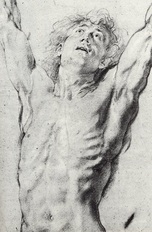
I have to thank the great George Donald for my knowledge of artistic anatomy. He was a rare inspiring tutor at eca who taught by example - demonstrating during classes and always exhibiting his work so that we could relate what he said to what he actually did. George also gave me my first teaching job at the college and this in turn led me to teach classes in anatomy to life drawing students. I remember one summer school when a particular group of American students arrived at the life class sporting baseball caps worn backwards and wielding pieces of string that they pointed in a slightly threatening way at the model in an attempt to gauge scale and proportion...one of them boasted that he read volumes of anatomy textbooks at night and could name every muscle known to medicine. I was terrified that I was out of my depth and unqualified to teach them. Curiously though, they couldn't draw for toffee. They could sketch out diagrammatic and anatomical looking figures, but there was no life to them, no sensitivity. The thing was they hadn't grasped that artistic anatomy is about looking and understanding form, how it changes from pose to pose but how it can be described sensitively and through a personal language of marks. The best book on the subject is by Robert Beverly Hale, formerly of the Metropolitan Museum of Art NYC, where he illustrates anatomical landmarks not with diagrams, but with drawings by the Great Masters from Raphael to Degas, so that the point about rendering form in an individual way is perfectly made. I shall return to the subject of human anatomy in a series of 3 Saturday workshops at WASPS studios in September, October and November - http://www.damiancallan.com/anatomy-workshops.html
 RSS Feed
RSS Feed